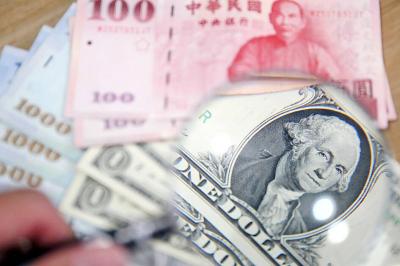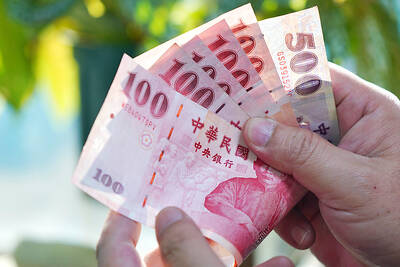The technology boom powering Asia’s economies is about to get a reboot.
Explosive growth in new-era gadgets such as wearable devices and Internet-linked home appliances is tipped to offset cooling sales of smartphones, which has already dinged Asia’s technology manufacturers.
“Where demand may be softening in some areas it will be strengthening in others,” IMF Regional Office for Asia and the Pacific official Koshy Mathai said in an interview.
He pointed to upcoming demand from “a vast middle class in China, India and other frontier markets.”
That is good news for the world economy.
The Asia-Pacific region accounts for 60 percent of global growth, much of it from a technology supply chain that is vulnerable to smartphone cycles.
The IMF is not alone in tipping the rise of a new technology cycle.
The world is in the early stages of a shift from the late-stage mobile Internet era to a new, data-centered computing era, Morgan Stanley analysts wrote in a report last month.
Crucially, it will be the first such era in which multiple technologies emerge at once, including the Internet of Things, artificial intelligence, and virtual and augmented reality, and it will require investment unparalleled since the launch of the Web in 1990, Morgan Stanley analysts said.
Take wearable devices.
Global sales of body-worn cameras are forecast to reach 5.6 million units in 2021, more than triple the 1.6 million this year, according to forecasts by Gartner Inc.
Smartwatch sales are expected to hit 81 million from 48 million over the same period, while those of head-mounted displays are to more than double to 67 million.
Spending on robotics and drones solutions is to reach US$103.1 billion this year, up 22 percent from last year, and more than double to US$218.4 billion by 2021, according to International Data Corp.
Taiwan, China, Japan and South Korea would be among the economies expected to benefit most — as they did from smartphones — with the new products stoking fresh demand for components such as semiconductors and displays.
That is expected to benefit manufacturers such as South Korea’s LG Display Co, which makes displays used in products including smartwatches and Bluetooth devices, and Samsung Electronics Co, which makes memory capacity.
Japan’s Sony Corp is developing 3D sensors that can be used in drones, self-driving automobiles, gaming consoles, industrial equipment and more.
“Manufacturers have always been able to shift their production line to cater to the newest trend in the market,” Singapore-based IDC senior research manager Kenneth Liew said. “We are now seeing products like wearables, smart home devices as some of the key products for future growth.”
The upbeat view comes as a more than year-long rebound in Asia’s exports has hit a speed bump, with softening industrial and manufacturing activity.
Smartphones contributed about one-sixth of the estimated growth in trade last year, according to the IMF.
Sales totaled close to 1.5 billion units last year — enough for one of every five people on the planet — but with more and more people already owning a smartphone, demand has peaked.
That is being felt at chip foundries and assembly plants across Asia.
Taiwan’s Pegatron Corp (和碩), which assembles Apple Inc’s iPhone 8, ramped up capacity in anticipation of a surge in business last year.
A subsequent shortfall in demand led to lower utilization rates across its factories and operating margins almost halved.
Both Pegatron and Hon Hai Precision Industry Co (鴻海精密) — Apple’s principal assemblers — reported declines in net income last year even as their biggest customer racked up record profits.
The smartphone sector is tapering off, not cratering, as evidenced by Apple’s results, and it will be some time before the emerging technology cycle reaches a point of matching demand generated through phone production, Hong Kong-based HSBC Holdings PLC cohead of Asian economics research Frederic Neumann said.
“While demand for consumer electronics like wearable devices and virtual reality headsets is growing rapidly, production runs still pale in comparison to smartphones,” Neumann said.
Of course, all bets are off if an all-out trade war erupts between China and the US.
Barring that, the next evolution in technology is poised to support global economic growth, even as smartphones reach saturation.
“It is fair to say that economists often don’t understand technology well enough to understand what it can do in terms of growth,” Mathai said.

The US dollar was trading at NT$29.7 at 10am today on the Taipei Foreign Exchange, as the New Taiwan dollar gained NT$1.364 from the previous close last week. The NT dollar continued to rise today, after surging 3.07 percent on Friday. After opening at NT$30.91, the NT dollar gained more than NT$1 in just 15 minutes, briefly passing the NT$30 mark. Before the US Department of the Treasury's semi-annual currency report came out, expectations that the NT dollar would keep rising were already building. The NT dollar on Friday closed at NT$31.064, up by NT$0.953 — a 3.07 percent single-day gain. Today,

‘SHORT TERM’: The local currency would likely remain strong in the near term, driven by anticipated US trade pressure, capital inflows and expectations of a US Fed rate cut The US dollar is expected to fall below NT$30 in the near term, as traders anticipate increased pressure from Washington for Taiwan to allow the New Taiwan dollar to appreciate, Cathay United Bank (國泰世華銀行) chief economist Lin Chi-chao (林啟超) said. Following a sharp drop in the greenback against the NT dollar on Friday, Lin told the Central News Agency that the local currency is likely to remain strong in the short term, driven in part by market psychology surrounding anticipated US policy pressure. On Friday, the US dollar fell NT$0.953, or 3.07 percent, closing at NT$31.064 — its lowest level since Jan.

The New Taiwan dollar and Taiwanese stocks surged on signs that trade tensions between the world’s top two economies might start easing and as US tech earnings boosted the outlook of the nation’s semiconductor exports. The NT dollar strengthened as much as 3.8 percent versus the US dollar to 30.815, the biggest intraday gain since January 2011, closing at NT$31.064. The benchmark TAIEX jumped 2.73 percent to outperform the region’s equity gauges. Outlook for global trade improved after China said it is assessing possible trade talks with the US, providing a boost for the nation’s currency and shares. As the NT dollar

The Financial Supervisory Commission (FSC) yesterday met with some of the nation’s largest insurance companies as a skyrocketing New Taiwan dollar piles pressure on their hundreds of billions of dollars in US bond investments. The commission has asked some life insurance firms, among the biggest Asian holders of US debt, to discuss how the rapidly strengthening NT dollar has impacted their operations, people familiar with the matter said. The meeting took place as the NT dollar jumped as much as 5 percent yesterday, its biggest intraday gain in more than three decades. The local currency surged as exporters rushed to